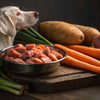Can Puppies Eat Raw Dog Food? A Comprehensive Guide to Feeding Your Pup Right
- Houndsy
Table of Contents
- Introduction
- Understanding Raw Dog Food
- Can Puppies Eat Raw Dog Food?
- The Importance of Hygiene
- Conclusion
Introduction
Picture this: you’ve just welcomed a fluffy little puppy into your home, full of energy and curiosity. As a proud pet parent, there’s nothing more important to us than ensuring our new fur baby grows up to be healthy and happy. Nutrition plays a pivotal role in that growth, but what exactly is the best way to feed our puppies? The idea of raw dog food is gaining traction among pet owners, but it raises a crucial question: Can puppies eat raw dog food?
The concept of feeding dogs a raw food diet, often referred to as the BARF (Biologically Appropriate Raw Food) diet, is rooted in the belief that a natural diet, mimicking what their ancestors would have eaten in the wild, can lead to optimal health. With a growing body of evidence supporting both the potential benefits and risks, understanding how and when to introduce raw food into a puppy's diet can be daunting.
In this blog post, we will explore what raw dog food entails, the advantages and disadvantages of this diet for puppies, and essential guidelines for safely introducing it. By the end of this read, you’ll be better equipped to make informed decisions regarding your puppy’s nutritional needs and overall well-being. We invite you to reflect on your own feeding routines and consider whether the raw diet might be a good fit for your little companion.
Understanding Raw Dog Food
What is Raw Dog Food?
Raw dog food consists primarily of raw meat, bones, organs, and sometimes fruits and vegetables—foods that dogs would have encountered in the wild. Advocates of the raw food diet assert that this type of feeding aligns with a dog's natural eating instincts and dietary requirements. The primary components of a raw diet typically include:
- Muscle meat: Often with bone.
- Bones: Raw, meaty bones are essential for providing nutrients and aiding in dental health.
- Organ meats: These include vital organs like liver, which are rich in essential vitamins.
- Raw eggs: A great source of protein and healthy fats.
- Vegetables and fruits: While not necessary, some owners include these for added nutrients.
The Evolution of Dog Food
Historically, dogs consumed diets based on what they could hunt or scavenged before commercial pet foods took over the market. The shift to processed foods, including kibble and canned meals, has raised questions about whether those options deliver the same nutritional value as a raw diet.
At Houndsy, we believe in addressing the everyday challenges of feeding dogs, ensuring that what we offer meets their needs without sacrificing quality, design, or aesthetics. While our focus is not directly on raw food diets, understanding the landscape of dog nutrition informs our commitment to ensuring that feeding experiences are as seamless as possible.
Can Puppies Eat Raw Dog Food?
Age Considerations
The age at which a puppy can safely transition to a raw food diet is a common concern for many dog owners. Generally, it’s recommended that puppies can start to be introduced to raw food as early as three weeks of age. At this age, they can begin the transition from mother’s milk to solid foods, which may include finely minced raw options.
However, it’s essential to consult with a veterinarian who has experience with raw feeding. Puppies have unique nutritional needs, especially as they undergo rapid growth and development.
Nutritional Needs of Puppies
Puppies are in a stage of significant growth, requiring a diet that provides adequate energy as well as essential nutrients:
- Protein: Critical for muscle development.
- Fats: Essential for energy and healthy skin and coat.
- Vitamins and minerals: Vital for their growing bodies, particularly calcium and phosphorus, which are crucial for bone health.
Beginning a raw food regimen must focus on creating meals that are balanced in these nutrients, and we can’t overemphasize the importance of consulting with a veterinary professional to avoid shortfalls or excesses that could lead to health issues.
Benefits of Feeding Raw Food to Puppies
When done correctly, raw food can provide several potential benefits for young puppies, including:
- Improved Digestion: Raw diets tend to be less processed, leading to higher digestibility. Puppies often experience reduced gas and firmer stools.
- Shinier Coat: Many raw food advocates report healthier skin and shinier coats due to the natural oils found in raw meats and fats.
- Dental Health: Chewing on bones can significantly aid in dental hygiene, helping to reduce plaque and tartar buildup.
- Increased Energy Levels: Owners often note that raw-fed dogs display higher energy and vitality.
Risks of Raw Feeding for Puppies
While there are benefits, it is essential to be aware of the potential risks associated with raw feeding, particularly for puppies:
- Nutritional Imbalance: A poorly balanced raw diet can lead to deficiencies (such as calcium or vitamin D) or excesses, which may contribute to health issues.
- Pathogens: Raw meat carries the risk of bacterial contamination (e.g., Salmonella, E. coli), which can affect both the puppy and humans handling the food.
- Choking Hazards: Whole bones pose a risk of choking or causing internal injuries if not carefully selected and monitored.
Transitioning to Raw Food
Transitioning your puppy from a commercial diet to a raw food diet should be approached slowly to allow their digestive system to adjust. Here are some steps to consider:
- Gradual Introduction: Begin with small amounts of raw food mixed with their current diet—about 25% raw and 75% regular food.
- Monitor Health: Keep an eye on your puppy’s stools and overall health. Loose stools might indicate the need to decrease raw food intake before increasing again.
- Rotate Proteins: Introducing different protein sources (like chicken, beef, or fish) can help provide a balanced nutrient profile and prevent food sensitivity.
- Personalize Diet: Every puppy is unique, so tailor their diet based on their size, activity level, and health needs, and consult a veterinary nutritionist if needed.
Recipes and Ideas for Raw Puppy Meals
If you decide to try a raw food approach, here are a few simple recipes to get started:
Chicken and Vegetable Mix
-
Ingredients:
- 70% raw chicken (muscle meat)
- 10% raw chicken liver (organ meat)
- 10% raw chicken heart (organ meat)
- 10% mixed vegetables (carrots, broccoli, spinach, etc.)
-
Instructions:
- Thaw the raw chicken.
- Dice the vegetables or use a food processor to chop them finely.
- Mix all ingredients in a bowl and serve.
Beef and Fish Blend
-
Ingredients:
- 50% raw beef (muscle meat)
- 20% raw beef kidney (organ meat)
- 20% raw fish (such as salmon or mackerel)
- 10% mixed leafy greens (like kale or collard greens)
-
Instructions:
- Cube the raw beef and fish.
- Grind or chop the kidney.
- Blend the ingredients together in a food processor.
These meal ideas not only cater to your puppy's nutritional needs but also bring excitement to their feeding experience!
The Importance of Hygiene
When transitioning to a raw food diet, sanitation becomes significantly more critical. Raw meats are prone to pathogens that could negatively impact both your puppy and your family. Here are some hygiene practices to adopt:
- Always wash your hands thoroughly after handling raw food.
- Clean feeding surfaces with disinfectant.
- Store leftovers promptly and at safe temperatures to avoid spoilage.
- Keep raw food separate from human food in preparation areas.
Conclusion
As we’ve explored, the question—can puppies eat raw dog food?—is not simply a yes or no answer. It’s a nuanced topic that requires careful consideration of age, nutritional needs, health factors, and hygiene practices. While raw feeding can provide various benefits, it also carries certain risks that must be managed with knowledge and care.
Choosing a feeding regimen for our furry companions is an opportunity to enhance their health and happiness, and every dog owner should reflect on their unique situation while exploring options. If you’re considering raw feeding as part of enhancing your pet care routine, take time to research and consult with professionals to ensure your puppy thrives.
And if you’re focused on making feeding time more convenient and stylish in your pet’s daily routine, don’t forget to check out our Houndsy Kibble Dispenser, which offers perfect portion control and complements your home decor beautifully.
FAQ
1. At what age can I start my puppy on a raw diet?
Most experts recommend introducing a raw diet around three weeks of age, but consulting with a veterinarian is crucial for tailored advice.
2. What should I feed my puppy on a raw diet?
A balanced raw diet typically includes muscle meat, raw bones, organ meats, eggs, and occasional vegetables. Consult a veterinary nutritionist for personalized meal plans.
3. What are the risks of feeding my puppy raw food?
Potential risks include nutritional imbalances, bacterial contamination, and choking hazards from bones. Careful sourcing and preparation can mitigate many of these risks.
4. How can I transition my puppy to a raw food diet?
Introduce raw food gradually by mixing it with their current diet and carefully monitoring their stools for adverse reactions.
5. Is a raw diet right for every puppy?
Not all puppies are suitable candidates for raw diets. Puppies with existing health issues or special dietary needs should be monitored closely or may require alternative feeding options.












